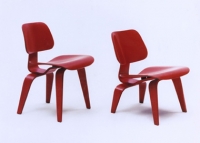Eames Chairs LCW and DCW
These molded plywood chairs with compound curved seats and backs and rubber shock mounts were designed by Charles Eames and produced by the Herman Miller Furniture Company.
The original concept was conceived by Charles Eames (1907-1978) in collaboration with architect Eero Saarinen (1910-1961) in 1940. In 1937, Eames had become head of the department of experimental design at Cranbrook Academy, and worked with Saarinen investigating plastics and furniture. Out of these efforts, Eames developed laminated and molded plywood splints, called Eames Splints, and in 1941 received an order for 5000 of them from the US Navy. Charles and his wife Ray produced the order in their Venice, CA studio and factory with the manufacturer, the Evans Products Company.
In 1941 the Museum of Modern Art held a competition organized by Eliot Noyes to discover imaginative designers for contemporary living. Prizes were awarded to Eames and Saarinen for these chairs and storage pieces, by a jury that included Edgar Kaufmann Jr., Alfred H. Barr of the Metropolitan Museum of Art, Eliot Noyes, Marcel Breuer, Frank Parrish, and architect Edward Durrell Stone.
The chairs were shown in 1946 in a Museum of Modern Art exhibition, New Furniture Designed by Charles Eames. At the time, the chairs had only three legs, and problems of stability discouraged mass production.
Early LCW (Low Chair-Wood) and DCW (Dining Chair-Wood) designs with four wooden legs were first produced in 1946 by Evans Products Company (Eames' wartime employer) and distributed by the Herman Miller Furniture Company. The tools were bought by George Nelson for Herman Miller in 1946 and took over manufacturing rights in 1949. Later versions with metal legs were produced in 1951, including the LCM (Low Chair-Metal) and DCM (Dining Chair-Metal) models. Matching dining and coffee tables were also produced. The line was produced until 1957, then re-issued in 1994. It was selected as "best design of the century" by Time magazine in 1999.
